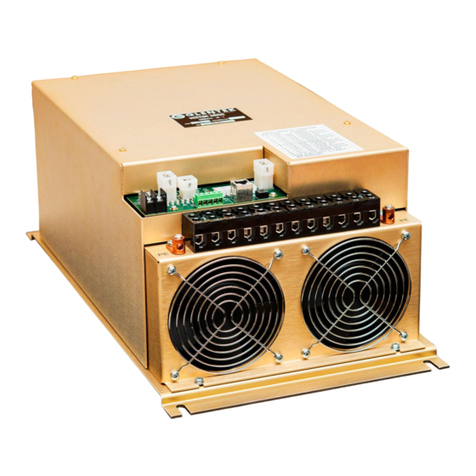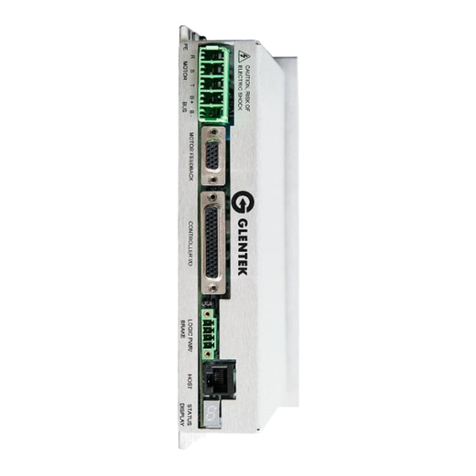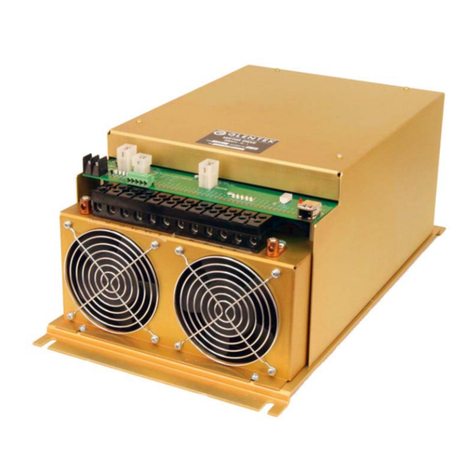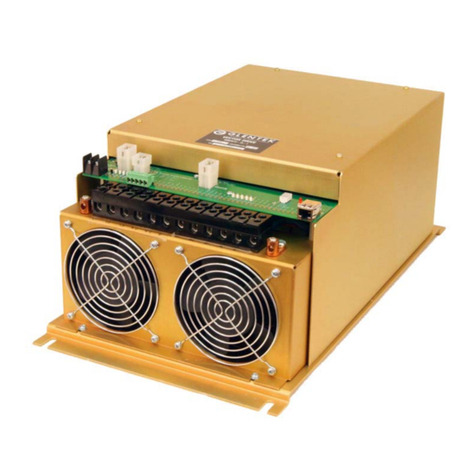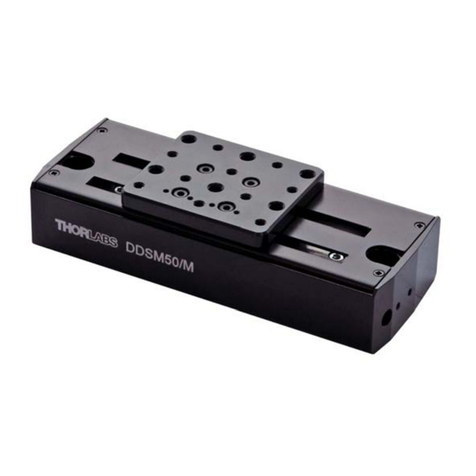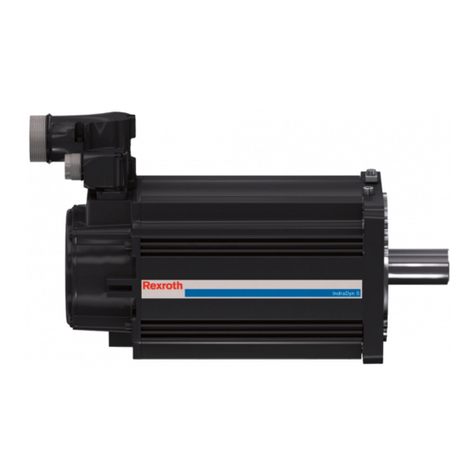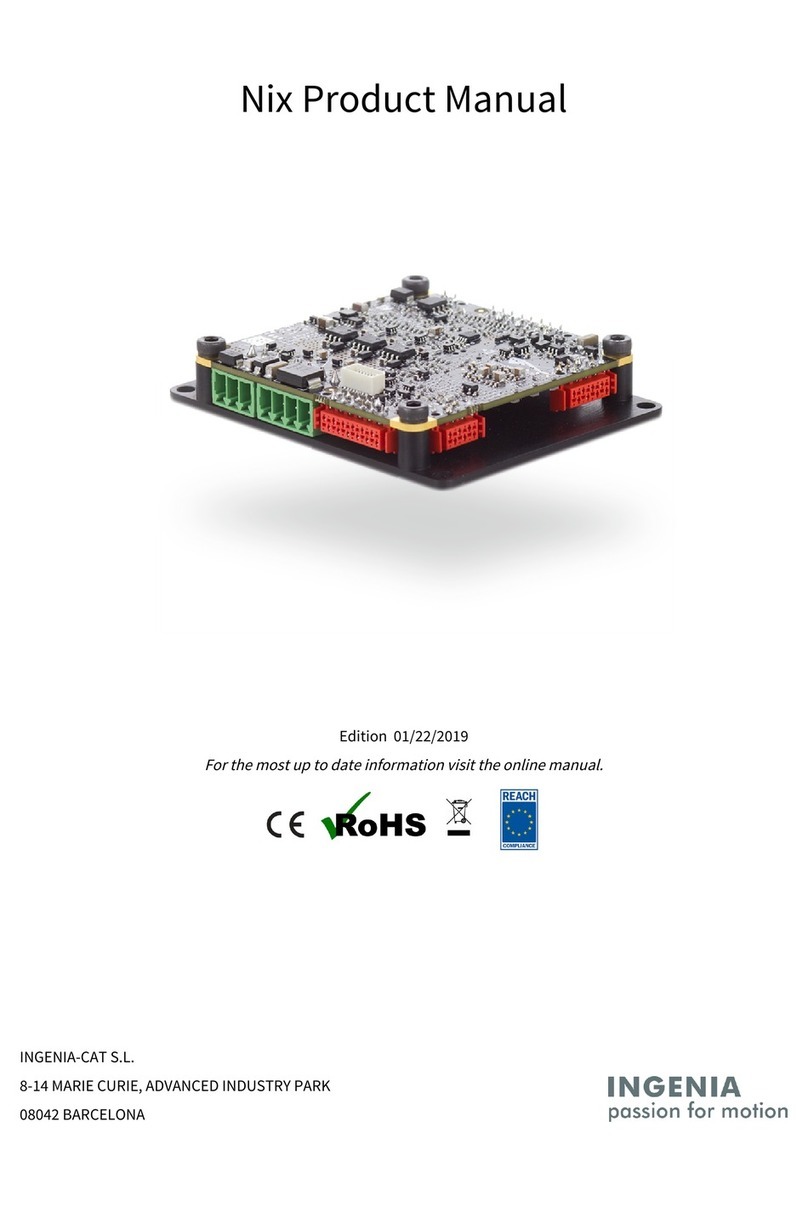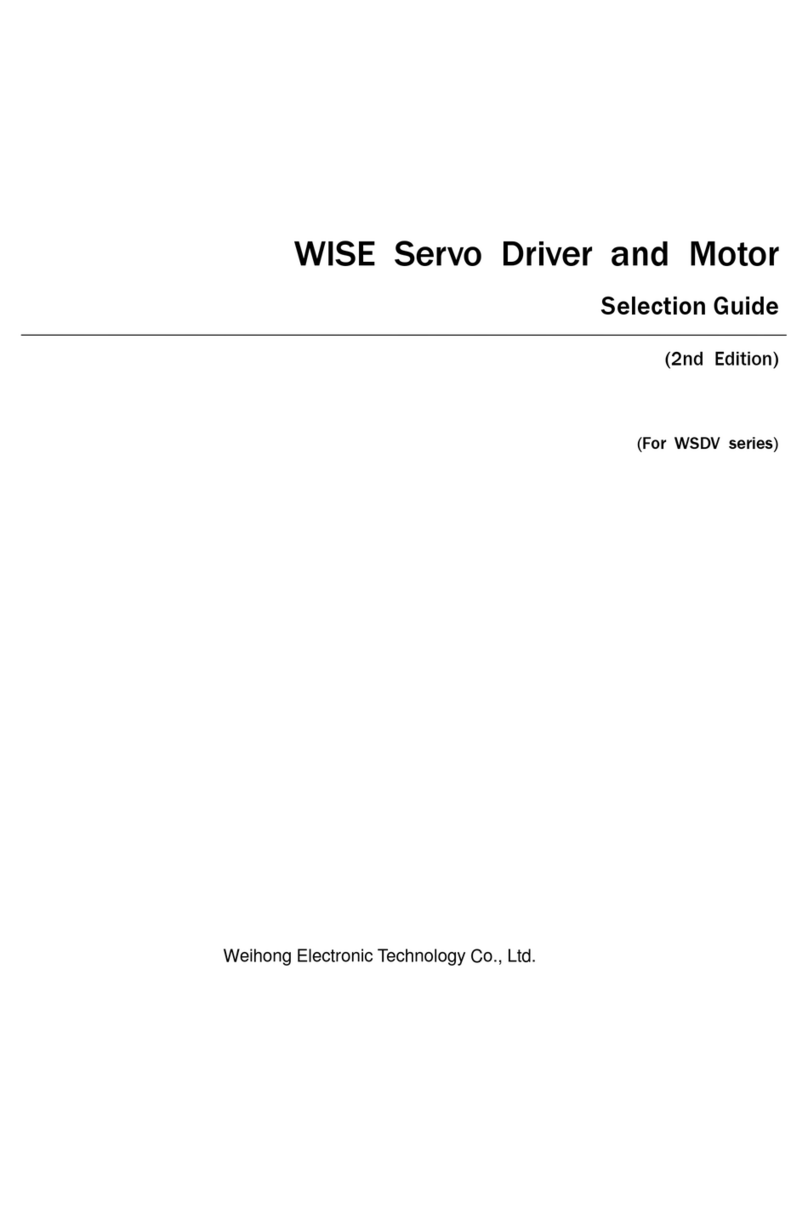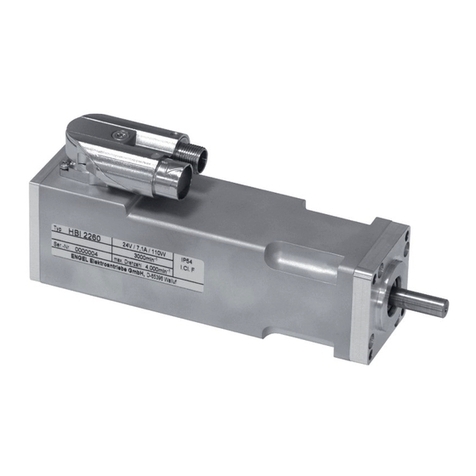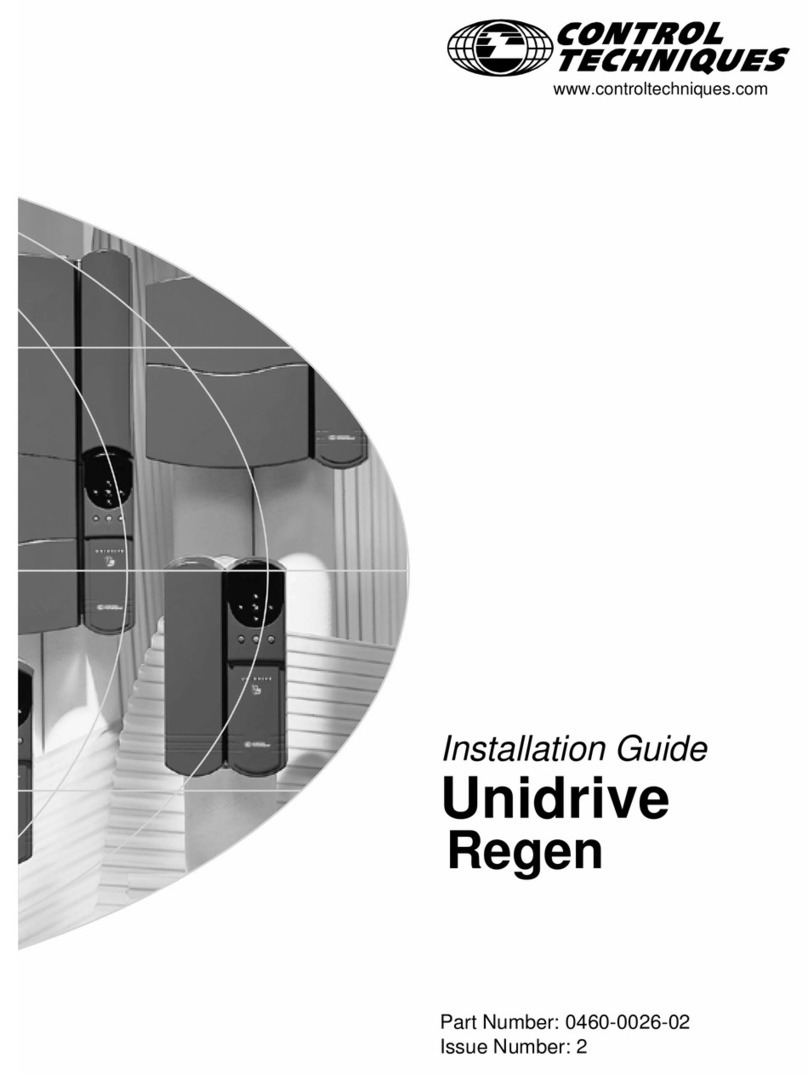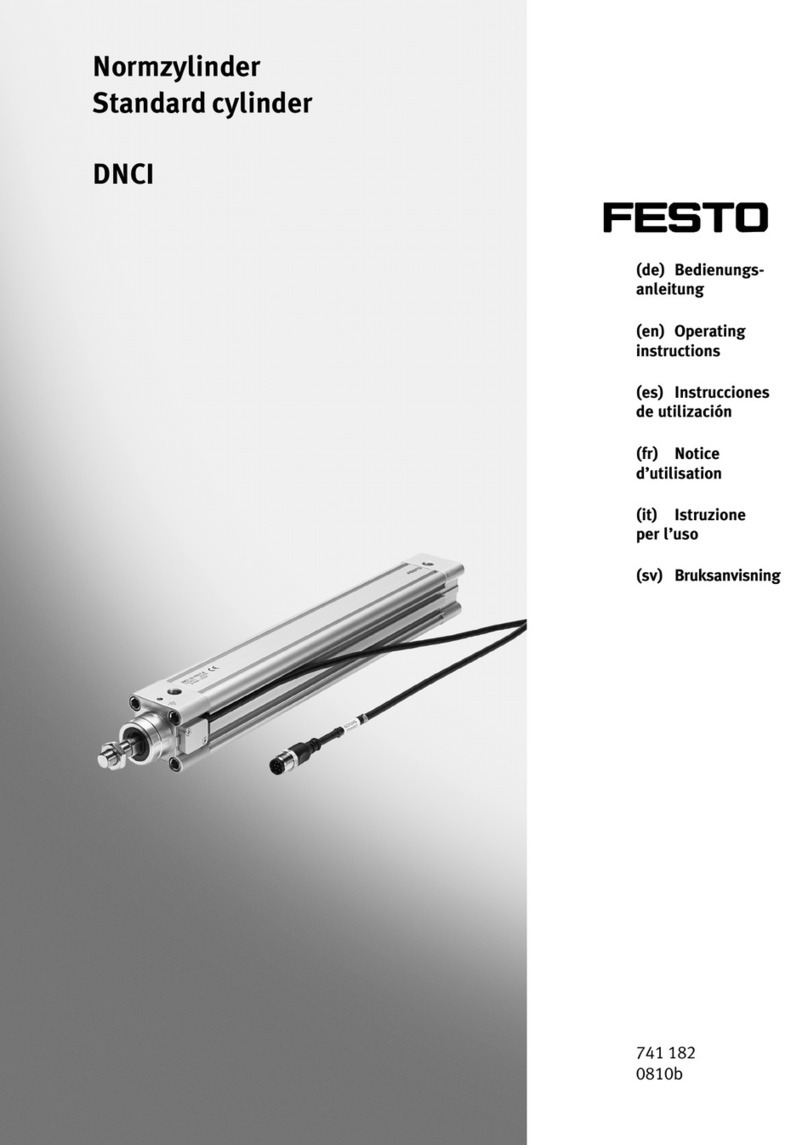Glentek SMA5005 User manual

OPERATION
&
SERVICE MANUAL
SMA5005 & SMA5015
H Bridge Linear Servo Drives

SMA5005 & SMA5015 MANUAL VIEW TABLE OF CONTENTS
2 glentek.com MANUAL # 5005-2040-000-F UPDATED: 6/1/2021
TABLE OF CONTENTS
TABLE OF CONTENTS ................................................................................................................................................... 2
INTRODUCTION ........................................................................................................................................................... 3
FEATURES.................................................................................................................................................................... 4
APPLICATION NOTE ..................................................................................................................................................... 5
TECHNICAL SPECIFICATIONS ........................................................................................................................................ 7
MODEL NUMBERING ...................................................................................................................................................8
START UP AND CALIBRATION .................................................................................................................................... 11
A. INITIAL START UP......................................................................................................................................................... 11
B. CALIBRATION OF THE VELOCITY MODE OF A STANDARD PERFORMANCE DRIVE (SMA5005 SERIES)............................................. 12
C. CALIBRATION OF THE CURRENT MODE OF A STANDARD PERFORMANCE DRIVE (SMA5005 SERIES) ............................................. 14
D. CALIBRATION OF THE CURRENT MODE OF A HIGH PERFORMANCE DRIVE (SMA5005-4 SERIES)................................................. 15
E. CALIBRATION SETUP RECORD (SMA5005 SERIES).............................................................................................................. 16
F. CALIBRATION OF THE VELOCITY MODE DRIVE (SMA5015 SERIES)......................................................................................... 17
G. CALIBRATION OF THE CURRENT MODE DRIVE (SMA5015 SERIES) ........................................................................................ 19
H. CALIBRATION SETUP RECORD (SMA5015 SERIES) ............................................................................................................. 20
APPENDIX.................................................................................................................................................................. 21
SMA5015, INSTALLATION................................................................................................................................................. 23
SMA5015, ELECTRICAL FUNCTIONAL BLOCK SCHEMATIC ........................................................................................................ 24
SMA5015, SCHEMATIC,INSTALLATION,POWER SUPPLY......................................................................................................... 25
SMA5015, PRINTED CIRCUIT BOARD ASSEMBLY,DRIVE ......................................................................................................... 26
SMA5015, PRINTED CIRCUIT BOARD ASSEMBLY,POWER SUPPLY............................................................................................. 27
SMA5005, INSTALLATION................................................................................................................................................. 28
SMA5005, LOGIC INPUT CONFIGURATION SETTINGS.............................................................................................................. 28
SMA5005, SCHEMATIC,INSTALLATION ............................................................................................................................... 30
SMA5005, PRINTED CIRCUIT BOARD ASSEMBLY,DRIVE ......................................................................................................... 31
SMA5005-4 HIGH PERFORMANCE,INSTALLATION ................................................................................................................ 32
SMA5005-2A-2, 2-AXIS BASEPLATE ASSEMBLY ................................................................................................................... 33
SMA5005-2A-4, 4-AXIS BASEPLATE ASSEMBLY ................................................................................................................... 34
T657TB, POWER TRANSFORMER ........................................................................................................................................ 35
T693TB, POWER TRANSFORMER ........................................................................................................................................ 36
EUROPEAN UNION EMC DIRECTIVES:ELECTROMAGNETIC COMPATIBILITY GUIDELINES.................................................................. 37
DECLARATION OF INCORPORATION MOTION CONTROL SYSTEMS............................................................................................... 42

VIEW TABLE OF CONTENTS
MANUAL# 5005-2040-000-F UPDATED: 6/1/2021 glentek.com 3
INTRODUCTION
The Glentek SMA5005 and SMA5015 H bridge Linear Servo Drives provide the optimum solution
for applications which require high current loop bandwidth, low radiated electrical noise, and low
crossover distortion. The SMA5015 Drive incorporates our latest generation ISO-BIAS current
sense technology, which provides one of the lowest drift linear Drives on the market today. These
Drives are constructed using surface mount technology and incorporate the latest in heat transfer
technology which make them one of the most powerful Drives for a given form factor.
Typical applications are brushed DC permanent magnet motors and voice coil motors.
The SMA5005 & SMA5015 are configurable and can operate in the following modes:
1. Velocity mode for motors with tachometer feedback*
2. Current mode for torque mode operation
*High performance models only support current mode
A basic velocity mode servo loop for a brush type motor is shown in figure A. An external controller
commands a given velocity (RPM). The velocity loop summing Drive compares this command with
the actual motor velocity, supplied by a DC tachometer on the motor shaft, and produces an error
voltage proportional to the difference between the actual and commanded velocity.
The velocity error is used to command motor current in the inner servo-loop. The current loop
summing Drive compares the command current (velocity error) with the actual current in the motor
and produces an error voltage proportional to the difference between the actual and commanded
current.
Finally, the current error signal is used to produce an output to drive the motor.
The velocity loop may be bypassed, and an external current command fed directly to the current
loop. In this case, the external command signal controls the torque of the motor, rather than the
velocity. This is known as current-mode operation.
Figure A - Velocity mode servo loop for a brush type motor

SMA5005 & SMA5015 MANUAL VIEW TABLE OF CONTENTS
4 glentek.com MANUAL # 5005-2040-000-F UPDATED: 6/1/2021
FEATURES
•Ergonomic Design Easy access to connections, adjustments and test points.
•SMT construction Provides ultra compact size, cost competitive package and high
reliability.
•Bandwidth Standard performance models have a nominal 10 kHz current loop
bandwidth which varies with the motor inductance.
High performance models (SMA5005-4) have a nominal 15 kHz
current loop bandwidth which varies with the motor inductance.
•Linear output stage Provides high bandwidth, low noise and zero crossover distortion.
•Multimode operation Velocity mode (tachometer feedback), Current mode (torque) and
voltage mode (SMA5015 only)
•Operating Voltage Operating input voltage range 17-0-17 to 39-0-39 VAC for standard
SMA5015 stand alone (higher voltages available) 24-75 VDC for
standard SMA5005 module.
•Basic versions Velocity and current modes (SMA5015 is field configurable).
High performance models (SMA5005-4) operate in current mode only
•Fault protection Short from output to output, short from output to ground, Drive RMS
over current, Drive under/over voltage (SMA5015 only) and Drive
over temperature.
•Status indicator 7-segment LED display indicates Drive status on the SMA5015 and
LEDs indicate status on the SMA5005.
•Dedicated inputs command signals, +/- limits, inhibit, reset, and fault. (Note: high
performance SMA5005-4 models only have reset and inhibit digital
inputs and the logic type and pull-up voltage is fixed. See model
numbering)
•Dedicated outputs fault out and motor current monitor
•Manual reset A push button reset is available to reset a fault (SMA5015 only).
•Current limit Peak motor current is adjustable.
•Transformer T657TB and T693TB are available for the SMA5015; see drawings in
the Appendix for more information.
•External fault reset An input is provided to reset the Drive in the event of a fault.
•CE compliant All servo Drives are CE marked.

VIEW TABLE OF CONTENTS
MANUAL# 5005-2040-000-F UPDATED: 6/1/2021 glentek.com 5
APPLICATION NOTE
POWER DISSIPATION CONSIDERATIONS AND CALCULATIONS WHEN USING
LINEAR DC SERVO DRIVES:
When selecting a linear Drive, the following ratings of the Drive should be known in order to
properly size the Drive to your system requirements:
1–The total wattage, peak current, and voltage rating of all the semiconductors installed on the
heat sink of the output power stage of the Drive.
Output transistor ratings for the SMA5005 series are:
Voltage: 250 Volts
Peak current: 60 A; Continuous current: 30 A (Normally shipped with 12-20A limit)
Total wattage @25 deg C.:1200 Watts
Output transistor ratings for the SMA5015 series are:
Voltage: 200 Volts
Peak current: 240 A; Continuous current: 60 A (Normally shipped with 20-50A limit)
Total wattage @25 deg C.:4480 Watts
The SMA5005 series Drive is a module requiring an external unregulated single polarity DC power
supply. Glentek offers various unregulated power supplies for the SMA5005 series Drives.
The SMA5005 series Drive is also available in multi-axis configurations. That is, there are two
basic baseplate assemblies namely 2-axis and 4-axis baseplate assemblies that have built-in AC
to DC power supplies (un-regulated) and cooling fans. The 2-axis baseplate assembly contains
one AC to DC power supply, one fan, and up to two SMA5005 Drive modules. The 4-axis
baseplate assembly contains one AC to DC power supply, two fans, and up to four SMA5005 Drive
modules. For multi-axis applications, it is always recommended to use three phases power
transformers for minimizing ripple voltage during high current demand scenarios where all axis
motors are running at full load simultaneously. Glentek offers various isolated three phases power
transformers.
The SMA5015 series is a stand-alone style Drive, meaning that the unregulated dual polarity
power supply is mounted within the Drive enclosure. Glentek offers 1.4KVA and 2.0KVA center
tapped power transformers for the SMA5015 series Drives.
2–Typical continuous internal power dissipation rating of the Drives running at normal room
conditions is:
SMA5005-xLB series (L-bracket heatsink); 100 Watts continuous
SMA5005-xSF series (short fin heatsink); 250 Watts continuous
SMA5015 series; 300 Watts continuous
For most applications, the above heat sinking is adequate. However, if you have a usage mode
where the heat sink temperature becomes excessive, please contact Glentek and we can furnish a
larger heat sink with greater air flow for your application.

SMA5005 & SMA5015 MANUAL VIEW TABLE OF CONTENTS
6 glentek.com MANUAL # 5005-2040-000-F UPDATED: 6/1/2021
Use the following relationships to calculate Drive dissipation:
1) Pd = Im x Vb (watts)
Where: Pd = Total watts delivered from bus
Im = Motor current
Vb = Bus voltage
2) Pm = Im x Vm (watts)
Where: Pm = Total power (watts) dissipated in motor
Vm = Motor voltage
3) Pa = Im x Vb - Im x Vm
Where: Pa = Total watts dissipated at Drive
From the above relationship, it can be surmised that the worst case dissipation occurs when the
Drive has to deliver a high continuous current at a low motor speed, i.e., less motor BEMF and
more current. For some applications, a power resistor can be added in series with the motor thus
shifting some of the power dissipation from the Drive to the resistor.

VIEW TABLE OF CONTENTS
MANUAL# 5005-2040-000-F UPDATED: 6/1/2021 glentek.com 7
TECHNICAL SPECIFICATIONS
Output
•SMA5005: 15A peak, 5A continuous, (forced air cooling required)
Note: Large motor and small motor versions have different velocity loop compensation.
•SMA5015: 25A peak, 10A continuous, (integral fan cooling)
Rated Internal Power Dissipation
•SMA5005-xLB series (L-bracket heatsink); 100 Watts continuous
•SMA5005-xSF series (short fin heatsink); 250 Watts continuous
•SMA5015 series; 300 Watts continuous
Input
•SMA5005: 24-75VDC
•SMA5015: 17-0-17VAC to 39-0-39VAC (+/-24 to +/-55VDC Bipolar Input)
•Integral forced air fan cooling (multi-axis SMA5005 and SMA5015 only)
•Analog command signals: differential & single ended, adjustable gain
•Manual reset Pushbutton switch (SMA5015 only)
•Reset: SMA5005: pull up/pull down, active high, active low
SMA5015: pull up/pull down, active high, active low
•Inhibit: Same as Reset
•+/- Limits: Same as Reset
Refer to Drive Configuration Code on page 11 for more information on signals input options
Output Connections
•Motor: MTR + & MTR-
•Fault out: SMA5005: Optically isolated can sink up to 50 mA, active high only
SMA5015: Open collector, Pulled Up (+5V), active high or active low
Bandwidth
•10 kHz maximum and varies with motor inductance for standard performance models
•15 kHz maximum and varies with motor inductance for high performance models
Status Indicator
•SMA5005: Green Run LED, Red Inhibit LED, Red Fault LED
•SMA5015: 7-segment LED display indicates Drive status and diagnostics
Mechanical
•SMA5005-xLB module: Height: 4.87”, Width: 1.20”, Depth: 7.13”
•SMA5005-xSF module: Height: 4.87”, Width: 1.88”, Depth: 7.13”
•SMA5005 2-Axis: Height: 6.93”, Width: 9.75”, Depth: 10.75”
•SMA5005 4-Axis: Height: 6.93”, Width: 14.88”, Depth: 10.75”
•SMA5015 stand-alone: Height: 9.00”, Width: 4.25”, Depth: 14.50”
Environmental
•Operating temperature 0 to 55°C
•Storage temperature -40 to 80°C
•Humidity 5 –95% relative (non-condensing)

SMA5005 & SMA5015 MANUAL VIEW TABLE OF CONTENTS
8 glentek.com MANUAL # 5005-2040-000-F UPDATED: 6/1/2021
MODEL NUMBERING
The information below should be used to order your Drive pre-configured for your application. You
may wish to have a Glentek application engineer confirm your configuration because field
configuration options are limited.
Standard Performance Drive Model Numbering:
Velocity Loop Compensation
Leave blank for standard performance current mode
drives
S = Small Motor (less than 3” in diameter)
L = Large Motor (3” or greater in diameter)
Drive Model Number
SMA5005—xx—bbb—1
Multi-Axis: 1 to 4 Axes
Drive Model Number
SMA5005—xx—bbb—eA-g
2 or 4 Axis Chassis
Velocity Loop Compensation
Leave blank for standard performance
current mode drives
S = Small Motor (less than 3” in diameter)
L = Large Motor (3” or greater in diameter)
Drive Configuration Code
See configuration algorithm on page 11
Drive Configuration Code
See configuration algorithm on page 11
Drive Model Number
Stand Alone
SMA5015—bbb—1A-1
Internal Heat Dissipation
LB = 100 W (L-bracket heatsink)
SF =250 W (Short fin heatsink)
Internal Heat Dissipation
LB = 100 W (L-bracket heatsink)
SF =250 W (Short fin heatsink)
Single Module
Drive Configuration Code
See configuration algorithm on page 11
Standard performance servo drives have a nominal 10 kHz current loop bandwidth
which varies with the motor inductance.

VIEW TABLE OF CONTENTS
MANUAL# 5005-2040-000-F UPDATED: 6/1/2021 glentek.com 9
High Performance Drive Model Numbering:
Drive Model Number
SMA5005—4x—34C—1
Multi-Axis: 1 to 4 Axes
Drive Model Number
SMA5005—4x—34C—eA-g
2 or 4 Axis Chassis
Drive Configuration Code
Hardwired: see configuration algorithm on
next page
Internal Heat Dissipation
LB = 100 W (L-bracket heatsink)
SF =250 W (Short fin heatsink)
Internal Heat Dissipation
LB = 100 W (L-bracket heatsink)
SF =250 W (Short fin heatsink)
Single Module
Drive Configuration Code
Hardwired: see configuration algorithm on
next page
High performance servo drives have a nominal 15 kHz current loop bandwidth which varies with
the motor inductance.
Standalone model only available as a standard performance servo drive
Note that high performance models have 34C fixed configuration code.
Reset is pulled down active high, inhibit is pulled up active high, and there are no +/- limits.
Signal input is set for differential, but can be configured for single ended input by externally
grounding one of the two signal input lines.
Due to the high performance and high current loop bandwidth, voice coil/motor parameters,
operating voltage, and desired current loop bandwidth are required upon ordering.

SMA5005 & SMA5015 MANUAL VIEW TABLE OF CONTENTS
10 glentek.com MANUAL # 5005-2040-000-F UPDATED: 6/1/2021
Inhibit, Reset, ±Limit Configuration
Type
Input is:
Input State:
Binary Code
A
Internally Pulled Up
Active When Low
00
C
Internally Pulled Up
Active When High
01
D
Internally Pulled Down
Active When Low
10
B
Internally Pulled Down
Active When High
11
Important Notes:
SMA5005 is not field configurable
except signal input
SMA5015 logic inputs are hard
wired, either pulled up or
pulled down at the factory
High performance SMA5005 has
configuration code 34C:
Reset is Pulled down, Active high
Inhibit is Pulled up, Active high
±Limit is Pulled up, Active high
Differential input
Current mode
+15V Input logic pull up voltage select
Logic Input Configuration for Inhibit
Type A
Requires grounding of input to disable the Drive.
Type B
Requires a positive voltage at input to disable the Drive.
Type C
Requires grounding of input to enable the Drive.
Type D
Requires a positive voltage at input to enable the Drive.
Differential or Single-ended input:
0 = Single-ended
1 = Differential.
Velocity or Current Mode:
0=Velocity; 1=Current.
Input Logic Pull Up Voltage Select
+15V / +5V
0 = +15V
1 = +5V
4 Bit Binary-to-Hexadecimal
Conversion
0000=0
1000=8
0001=1
1001=9
0010=2
1010=A
0011=3
1011=B
0100=4
1100=C
0101=5
1101=D
0110=6
1110=E
0111=7
1111=F
0
0
0
±Limit 0=Active Low, 1= High
±Limit 0=Pulled Up, 1= Down
Inhibit 0=Active Low, 1= High
Inhibit 0=Pulled Up, 1= Down
Reset 0=Active Low, 1= High
Reset 0=Pulled Up, 1= Down
Drive Configuration Code
Insert 3 digit hexadecimal code into “Drive
Configuration Code”section of model
numbering (bbb).

VIEW TABLE OF CONTENTS
MANUAL# 5005-2040-000-F UPDATED: 6/1/2021 glentek.com 11
START UP AND CALIBRATION
This section contains the procedure required for initial start up and Drive calibration. The standard
performance SMA5005 and SMA5015 series Drives can be configured to run in velocity mode and
current mode. The high performance SMA5005 Drives can only run in current mode.
Required Equipment: Oscilloscope, voltmeter & battery box. The battery box serves as a step input
voltage command, applying and removing a flashlight battery can also be used for this function.
Glentek sells a battery box BB-700 which is ideal for this function.
Refer to the technical specifications page and the drawings in the appendix for the information
needed to supply the correct power and to wire the model you are starting up. An isolation
transformer is needed for the multi-axis SMA5005 and SMA5015. An isolated power supply
(unregulated is OK) providing the necessary voltage is required for the SMA5005 module. Glentek
can provide appropriate transformers and power supplies. Consult a Glentek applications engineer
or sales person for assistance.
A. Initial Start Up
When applying power to start up your Drive system for the first time, we recommend you follow this
procedure. If you have already gone through this procedure, you can skip to the appropriate
calibration procedure.
1. Check for any loose or damaged components.
2. Check that all connections are tight.
3. Be sure that the motor mechanism is clear of obstructions. If the mechanism has limited
motion, e.g. a lead-screw, set the mechanism to mid-position.
4. Disconnect the signal and auxiliary inputs.
5. Be sure the Loop-Gain pot(s) are fully CCW (RV7 for SMA5005, and RV4 for SMA5015). This
will prevent the motor from running away in velocity mode when power is applied.
6. Check for the correct AC voltage before connecting to SMA5005 multi-axis or SMA5015 Drives.
The DC Bus (Drive supply-voltage) will be 1.4 times greater than the AC value. If the voltage is
correct, remove power and connect AC source to Drive inputs. For SMA5005 module Drive,
check for the correct DC voltage before connecting to the Drive power input.
7. Work on only one Drive axis at a time for SMA5005 multi-axis Drives.

SMA5005 & SMA5015 MANUAL VIEW TABLE OF CONTENTS
12 glentek.com MANUAL # 5005-2040-000-F UPDATED: 6/1/2021
B. Calibration of the Velocity Mode of a Standard Performance Drive
(SMA5005 Series)
The Drive, in this configuration, receives an analog, bi-polar input command, which is proportional
to the motor velocity. The Drive receives velocity feedback from a tachometer, which is usually
mounted to the rear of the motor. The following pots will be set during calibration: (Note: RV7 is a
single turn pot and RV1-RV5 are 20-turn pots.)
PROCEDURE:
1. Connect motor cables to DC Input/Motor Output pin 4 (MOTOR+) and DC Input/Motor Output
pin 5 (MOTOR-). Connect the motor ground to the chassis ground (or PE).
2. Connect the Tach. wires to Controller I/O pin 3 (TACH IN-) and Controller I/O pin 4 (TACH IN+
‘GND’).
3. Apply main power and fan power. Visually confirm a green LED. Depending on the
configuration of the Inhibit, Reset and +/-Limits, it may be necessary to make appropriate
connections to those terminals before the Drive will be enabled and energize the motor.
4. Slowly turn the Loop Gain (RV7) CW fully. Motor should be stopped or turning slowly. If the
motor starts running away, remove the power, reverse the Tach. leads, and apply power.
5. Set Balance (RV2) for zero motor rotation.
6. Connect oscilloscope probe to Controller I/O pin 7 (CURRENT SENSE) and oscilloscope
ground to Controller I/O pin 13, 14 or 15 (SIGNAL GND). Connect battery box to Controller I/O
pin 1 (SIGNAL+) and Controller I/O pin 2 (SIGNAL-). The voltage on Controller I/O pin 7 is a
function of motor current: 1V = 2.0A. While applying a step input voltage, adjust the Current
Limit (RV5) for desired peak current.
7. The purpose of the following procedure is to set the system bandwidth to obtain a critically-
damped response (see figure B) or a one hook overshoot response with the maximum possible
Tach. Gain. There are many possible settings of Tach. Gain and Compensation which will yield
the desired waveform: The optimum setting will occur when Tach. Gain is as CW as possible
and Compensation is as CCW as needed. However, the velocity loop may become unstable
(the motor oscillates or hums) as the Compensation is tuned CCW (increasing the BW). In this
case, stability is the limiting factor: At no time should the velocity loop be allowed to be
unstable. Drives are normally shipped with the Tach. Gain (RV4) set at 100%. This is a good
place to start. If you are unsure of where the Tach. Gain is set, turn the Tach. Gain (RV4) fully
CW (up to 20 turns).
8. Connect oscilloscope probe to Controller I/O pin 3 (TACH IN-) and oscilloscope ground to
Controller I/O pin 13, 14 or 15. Set battery box for a DC signal output to obtain approximately
400RPM. The RPM may be set by measuring the Tach. voltage at Controller I/O pin 3, e.g.,
2.8VDC for a 7V/KRPM Tach. is 400RPM.
Pots
Name of Pot
Notes
RV1
Signal Gain, SIG
Sets the input voltage to velocity ratio.
RV2
Balance, BAL
Used to null any offset in the system.
RV3
Compensation, COMP
Used in conjunction with Tach. Gain to set the system
bandwidth.
RV4
Tach. Gain, TACH
Sets the DC tachometer gain.
RV5
Current Limit, I LIMIT
Sets the maximum motor current. Shipped set CW (max).
RV7
Loop Gain,
LOOP GAIN
Used to shut off uncalibrated Drives. When the loop gain is fully
CCW, no current is delivered to the motor.

VIEW TABLE OF CONTENTS
MANUAL# 5005-2040-000-F UPDATED: 6/1/2021 glentek.com 13
9. Pulse the input and compare the waveform with figure B.
10. Adjust the Compensation pot (RV3) CCW until the waveform is critically damped or one hook
overshoot. If the desired waveform cannot be obtained by adjusting the Compensation pot
before the motor becomes unstable, back off the Tach. Gain pot (CCW) a few turns.
11. Do not adjust the Tach. Gain or Compensation for the rest of the calibration procedure.
12. Set battery box for a known DC voltage (+/-10V). Adjust the Signal Gain pot (RV1) and set the
ratio based on the desired motor velocity.
13. Calibration complete.
14. Now connect the computer control (CNC). If the motor is rotating in the wrong direction for a
given input polarity, power down. Reverse both the motor and Tach. leads.
Figure B - Critically damped, One Hook Overshoot, Under and Over damped waveforms

SMA5005 & SMA5015 MANUAL VIEW TABLE OF CONTENTS
14 glentek.com MANUAL # 5005-2040-000-F UPDATED: 6/1/2021
C. Calibration of the Current Mode of a Standard Performance Drive
(SMA5005 Series)
The Drive in this configuration receives an analog, bi-polar input command, which is proportional to
the required motor current (motor torque). The following potentiometers (pots) will be set during
calibration: (Note: RV7 is a single turn pot and RV1-RV5 are 20-turn pots.)
PROCEDURE:
1. Apply main power and fan power. Visually confirm a green LED. Depending on the
configuration of the Inhibit, Reset and +/-Limits, it may be necessary to make appropriate
connections to those terminals before the Drive will be enabled and energize the motor.
2. Slowly turn the Loop Gain (RV7) pot CW fully. The Motor should be stopped or turning slowly.
Set the Balance (RV2) for 0V across DC Input/Motor Output pin 4 to DC Input/Motor Output pin
5.
3. Connect oscilloscope probe to Controller I/O pin 7 (CURRENT SENSE) and oscilloscope
ground to Controller I/O pin 13, 14 or 15 (SIGNAL GND). Connect battery box to Controller I/O
pin 1 (SIGNAL+) and Controller I/O pin 2 (SIGNAL-). The voltage on Controller I/O pin 7 is a
function of motor current: 1V = 2.0A.
4. To set the current limit at some value less than the maximum, apply a large step command and
observe peak above desired peak current. Turn current limit pot CCW until peak current is
reduced to desired value.
5. Apply a step command of 3-4 volts. Observe commanded motor (scale is 10A/V) and set the
desired signal to current ratio. For example, 3A/V.
6. If the motor is rotating in the wrong direction for a given input polarity, power down and reverse
the motor leads.
7. Calibration complete.
Pots
Name of Pot
Notes
RV1
Signal Gain, SIG
Sets the input voltage to current ratio.
RV2
Balance, BAL
Used to null any offset in the system.
RV3
Compensation, COMP
Used in conjunction with Tach. Gain to set the system
bandwidth.
RV4
Tach. Gain, TACH
Sets the DC tachometer gain.
RV5
Current Limit, I LIMIT
Sets the maximum motor current. Shipped set CW (max).
RV7
Loop Gain,
LOOP GAIN
Used to shut off uncalibrated Drives. When the loop gain is
fully CCW, no current is delivered to the motor.

VIEW TABLE OF CONTENTS
MANUAL# 5005-2040-000-F UPDATED: 6/1/2021 glentek.com 15
D. Calibration of the Current Mode of a High Performance Drive
(SMA5005-4 Series)
The Drive in this configuration receives an analog, bi-polar input command, which is proportional to
the required motor current (motor torque). The following potentiometer (pot) will be set during
calibration: (Note: Balance Pot is a 20-turn pot.)
Calibration is minimal compared to standard performance Drives. The Drive will be custom tuned at
the factory for the specific application. Therefore, voice coil/motor parameters, operating voltage,
and desired current loop bandwidth are required upon ordering. The only user tunable parameter is
balance/current offset.
PROCEDURE:
1. Apply main power and fan power. Visually confirm a green LED. Depending on the
configuration of the Inhibit and Reset pins, it may be necessary to make appropriate
connections to those terminals before the Drive will be enabled and energize the motor.
2. The Motor should be stopped or turning slowly. Set the Balance Pot for 0V across DC
Input/Motor Output pin 4 to DC Input/Motor Output pin 5.
3. If the motor is rotating in the wrong direction for a given input polarity, power down and reverse
the motor leads.
4. Calibration complete.
Name of Pot
Notes
BALANCE POT
Used to null any offset in the system.

SMA5005 & SMA5015 MANUAL VIEW TABLE OF CONTENTS
16 glentek.com MANUAL # 5005-2040-000-F UPDATED: 6/1/2021
E. Calibration Setup Record (SMA5005 Series)
It is good practice to keep a record of all the pot settings. Doing so will facilitate calibration on
future units and repair on this unit. Although not a substitute for the calibration procedure, it will at
least get you "in the ballpark." Remove the power and allow all capacitors to discharge before
taking measurements.
Note: The balance pot should not be measured in this fashion, set per step 3 in the calibration
procedure.
Note: Tach. voltage is measured at Controller I/O pin 3. Common for all measurements is at
Controller I/O pin 4.
Date data taken: / /
Serial number S/N: _________________________________
Model number: SMA5005_________________________
Note any changes to components or any special features in the space below:
Pot/Dip-Switches
AMP1
AMP2
AMP3
AMP4
Signal Gain pot wiper
TP2 to common (ohms):
Tach. Gain pot wiper
TP3 to common (ohms):
Compensation pot wiper
TP4 to common (ohms):
Current Limit pot wiper
TP5 to common (ohms):

VIEW TABLE OF CONTENTS
MANUAL# 5005-2040-000-F UPDATED: 6/1/2021 glentek.com 17
F. Calibration of the Velocity Mode Drive (SMA5015 Series)
The Drive, in this configuration, receives an analog, bi-polar input command, which is proportional
to the motor velocity. The Drive receives velocity feedback from a tachometer, which is usually
mounted to the rear of the motor. The following pots will be set during calibration: (Note: RV7 is a
single turn pot and RV1-RV6, RV8-RV10 are 20-turn pots.)
Note: RV9 and RV10 are factory set and should not be adjusted. Adjusting these pots voids
warranty.
PROCEDURE:
1. Connect motor cables to TB1 MTR+ and MTR-. Connect the motor ground to chassis ground.
2. Connect the Tach. wires to J1-5 (TACH. INPUT) and J1-11 (COMMON).
3. Apply main power and fan power. Visually confirm an “O” on the 7-segment display. Depending
on the configuration of the Inhibit, Reset and +/-Limits, it may be necessary to make
appropriate connections to those terminals before the Drive will be enabled and energize the
motor.
4. Slowly turn the Loop Gain (RV7) CW. Motor should be stopped or turning slowly. If the motor
starts running away, remove the power, reverse the Tach. leads, and apply power.
5. Set Balance (RV3) for zero motor rotation.
6. Set the desired peak current limit by adjusting RV6 while measuring voltage at TP6. The ratio is
1V=6A.
7. The purpose of the following procedure is to set the system bandwidth to obtain a critically-
damped response (see figure C) or a one hook overshoot response with the maximum possible
Tach. Gain. There are many possible settings of Tach. Gain and Compensation which will yield
the desired waveform: The optimum setting will occur when Tach. Gain is as CW as possible
and Compensation is as CCW as needed. However, the velocity loop may become unstable
(the motor oscillates or hums) as the Compensation is tuned CCW (increasing the BW). In this
case, stability is the limiting factor: At no time should the velocity loop be allowed to be
unstable. Drives are normally shipped with the Tach. Gain (RV4) set at 100%. This is a good
place to start. If you are unsure of where the Tach. Gain is set, turn the Tach. Gain (RV4) fully
CW (up to 20 turns).
Pots
Name of Pot
Notes
RV1
Differential Gain, AUX
Sets the input voltage to velocity ratio for differential signal input.
RV2
Signal Gain, SIG
Sets the input voltage to velocity ratio for single-ended signal
input.
RV3
Balance, BAL
Used to null any offset in the system.
RV4
Tach. Gain, TACH
Sets the DC tachometer gain.
RV5
Compensation, COMP
Used in conjunction with Tach. Gain to set the system bandwidth.
RV6
Current Limit, I LIMIT
Sets the maximum motor current. Shipped set CW (max).
RV7
Loop Gain,
LOOP GAIN
Used to shut off uncalibrated Drives. When the loop gain is fully
CCW, no current is delivered to the motor.

SMA5005 & SMA5015 MANUAL VIEW TABLE OF CONTENTS
18 glentek.com MANUAL # 5005-2040-000-F UPDATED: 6/1/2021
8. Connect oscilloscope probe to J1-5 (TACH INPUT) and oscilloscope ground to J1-11
(COMMON). Set battery box for a DC signal output to obtain approximately 400RPM. The RPM
may be set by measuring the Tach. voltage at J1-5, e.g., 2.8VDC for a 7V/KRPM Tach. is
400RPM.
9. Pulse the input and compare the waveform with figure C.
10. Adjust the Compensation pot (RV5) CCW until the waveform is critically damped or one hook
overshoot. If the desired waveform cannot be obtained by adjusting the Compensation pot
before the motor becomes unstable, back off the Tach. Gain pot (CCW) a few turns.
11. Do not adjust the Tach. Gain or Compensation for the rest of the calibration procedure.
12. Set battery box for a known DC voltage (+/-10V). Adjust the AUX. Gain (RV1) pot for
differential Gain or SIG. Gain (RV2) for single-ended input to set the ratio based on the desired
motor velocity.
13. Calibration complete.
14. Now connect the computer control (CNC). If the motor is rotating in the wrong direction for a
given input polarity, power down. Reverse both the motor and Tach. leads.
Figure C - Critically damped, One Hook Overshoot, Under and Over damped waveforms

VIEW TABLE OF CONTENTS
MANUAL# 5005-2040-000-F UPDATED: 6/1/2021 glentek.com 19
G. Calibration of the Current Mode Drive (SMA5015 Series)
The Drive in this configuration receives an analog, bi-polar input command, which is proportional to
the required motor current (motor torque). The following potentiometers (pots) will be set during
calibration: (Note: RV7 is a single turn pot and RV1-RV6, RV8-RV10 are 20-turn pots.)
PROCEDURE:
1. Apply the main power and fan power. Visually confirm an “O” on the display. Depending on the
configuration of the Inhibit, Reset and +/-Limits, it may be necessary to make appropriate
connections to those terminals before the Drive will be enabled and energize the motor.
2. Slowly turn the Loop Gain (RV7) pot CW. The Motor should be stopped or turning slowly. Set
the Balance (RV3) for 0V across TB1 MTR.+ to TB1 MTR.-.
3. Set the desired peak current limit by adjusting RV6 while measuring voltage at TP6. The ratio is
1V = 6A. Battery box does not have to be connected to the Drive.
4. If AUX. Gain is desired, monitor voltage across J1-1 (AUX. INPUT) to J1-2 (AUX. RETURN). If
SIG. Gain is desired, monitor voltage across J1-3 (SIG. INPUT) to J1-4 (SIG. COM.). To set the
desired signal to current ratio for AUX. Gain adjust the RV1 (differential signal) pot and for SIG.
Gain adjust the RV2 (single-ended signal) pot. Apply a step command of 3-4 volts. Observe
commanded motor (scale is 10A/V) and set the desired signal to current ratio. For example,
3A/V (max is 30A/10V).
5. If the motor is rotating in the wrong direction for a given input polarity, power down and reverse
the motor leads.
6. Calibration complete.
Pots
Name of Pot
Notes
RV1
Differential Gain, AUX
Sets the input voltage to current ratio for differential signal
input.
RV2
Signal Gain, SIG
Sets the input voltage to current ratio for single-ended signal
input.
RV3
Balance, BAL
Used to null any offset in the system.
RV4
Tach. Gain, TACH
Sets the DC tachometer gain.
RV5
Compensation, COMP
Used in conjunction with Tach. Gain to set the system
bandwidth.
RV6
Current Limit, I LIMIT
Sets the maximum motor current. Shipped set CW (max).
RV7
Loop Gain,
LOOP GAIN
Used to shut off uncalibrated Drives. When the loop gain is
fully CCW, no current is delivered to the motor.

SMA5005 & SMA5015 MANUAL VIEW TABLE OF CONTENTS
20 glentek.com MANUAL # 5005-2040-000-F UPDATED: 6/1/2021
H. Calibration Setup Record (SMA5015 Series)
It is good practice to keep a record of all the pot settings. Doing so will facilitate calibration on
future units and repair on this unit. Although not a substitute for the calibration procedure, it will at
least get you "in the ballpark." Remove the power and allow all capacitors to discharge before
taking measurements. Note: The balance pot should not be measured in this fashion, set per step
3 in the calibration procedure.
Note: Tach. voltage is measured at J1-5. Common for all measurements is at J1-4.
Date data taken: / /
Serial number S/N: _________________________________
Model number: SMA5015_________________________
Note any changes to components or any special features in the space below:
Pot/Dip-Switches
Drive
Differential Gain pot wiper
TP1 to common (ohms):
Signal Gain pot wiper
TP2 to common (ohms):
Tach. Gain pot wiper
TP4 to common (ohms):
Compensation pot wiper
TP5 to common (ohms):
Current Limit pot wiper
TP6 to common (ohms):
Other manuals for SMA5005
1
This manual suits for next models
1
Table of contents
Other Glentek Servo Drive manuals
Popular Servo Drive manuals by other brands

THORLABS
THORLABS TBD001 user guide
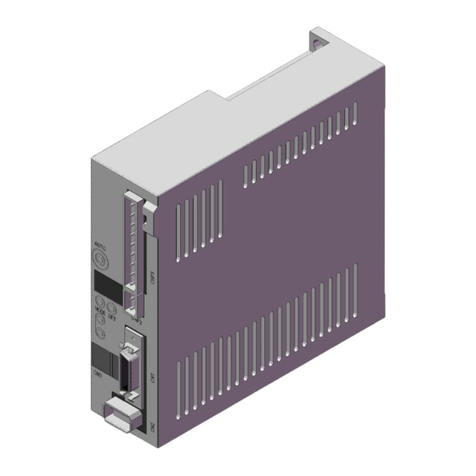
SMC Networks
SMC Networks LECSA Series Operation manual

Omron
Omron 1S Series Startup guide
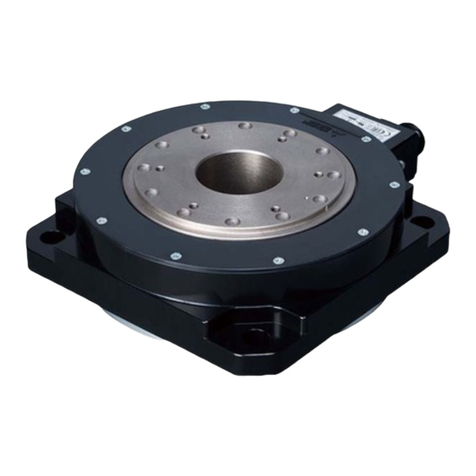
Mitsubishi Electric
Mitsubishi Electric TM-RFM instruction manual

Beckhoff
Beckhoff AMP8500 operating instructions
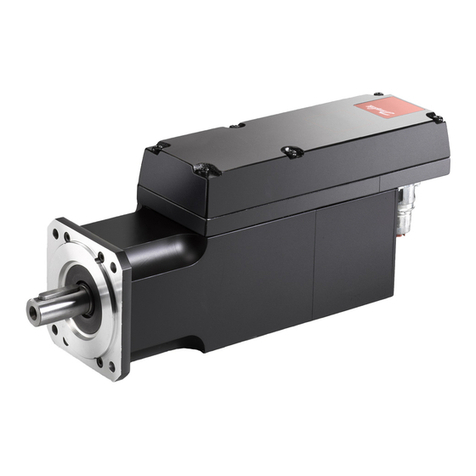
Danfoss
Danfoss VLT Integrated Servo Drive ISD 510 System operating guide
